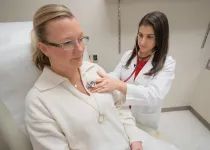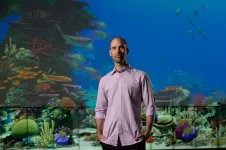(Press-News.org) Could 2025 be the year marine protection efforts get a “glow up”? According to a team of conservation-minded researchers, including Octavio Aburto of UC San Diego’s Scripps Institution of Oceanography, the moment has arrived.
In a new study published Feb. 6 in the journal Frontiers in Marine Science, Aburto and a multinational team of marine scientists and economists unveil a comprehensive framework for Marine Prosperity Areas, or MPpAs. With a focus on prosperity—the condition of being successful or thriving—this science-informed effort aligns human well-being with the restoration of designated marine and coastal environments.
Marine Prosperity Areas mark a more holistic approach to marine conservation, with a framework that seeks to use targeted financial investments to enhance human prosperity during periods of active ecological restoration. To fully realize the vision for Marine Prosperity Areas, the study authors are calling on governments, non-governmental organizations, and local stakeholders to champion MPpAs as a cornerstone of global conservation efforts, committing to the investments and partnerships necessary to build a sustainable future.
“Conservation often demands sacrifices today for benefits decades in the future—an unrealistic expectation for communities facing immediate socio-economic pressures,” said Aburto, lead author of the study and professor of marine biology at Scripps Oceanography. “Our model for Marine Prosperity Areas addresses this challenge, outlining how human prosperity can be improved while we wait for ecological recovery. By strategically aligning recovery efforts, it is possible for both people and ecosystems to thrive.”
If implemented, Marine Prosperity Areas have the power to be a leading tool for achieving global conservation targets, said the authors. This includes the "30 by 30" target set by the Kunming-Montreal Global Biodiversity Framework, an international commitment to protect 30% of the world's oceans by 2030.
The new framework builds upon several decades of research on Marine Protected Areas (MPAs), fisheries, and coastal habitats in Baja California Peninsula, Mexico, and throughout the Gulf of California—one of the world’s most important marine hotspots. The authors recognized the need to transform the existing model for implementing marine protections because, despite decades of efforts, there has been no unifying framework. The new model employs strategic financial investments and tailored community partnerships to align the realms of ecological conservation, economic growth, environmental responsibility, and social policy—ultimately benefiting both people and the planet.
For example, in marine areas with great natural beauty, seed funding could promote ecotourism by supporting community-based diving or snorkeling enterprises. In other areas, small grants could help locals establish sustainable aquaculture initiatives or fund technological efforts to create artificial reefs for environmental restoration. Overall, the focus is on nurturing opportunities for community members to diversify their livelihoods, sustainably manage natural resources, and drive economic growth.
“The concept of Marine Prosperity Areas can help us to bridge the gap between environmental and social outcomes,” said study co-author Alfredo Giron, a Scripps Oceanography alumnus now serving as head of the World Economic Forum's Ocean Action Agenda and Friends of Ocean Action. “It gives us the opportunity to understand that nature and people are inextricably linked and as such, a marine management plan has to pursue outcomes for both.”
The authors identified three distinct phases—called “Pillars on Intervention”—that characterize the establishment of a Marine Prosperity Area:
Community Engagement and Co-Design: The primary focus is to mobilize the community and actively engage all relevant stakeholders in collaboratively defining prosperity and envisioning pathways to achieve it. This phase prioritizes the co-design of sustainable strategies for using marine resources and aligns with the aspirations of the local community, fostering a sense of inclusion.
Capacity Building, Governance, and Infrastructure: The goal of this stage is to establish the essential building blocks for the Marine Prosperity Area. This includes investing in community capacity to design and implement the MPpA, developing a governance system with legal and statutory frameworks to oversee it, integrating conflict resolution mechanisms, and creating the infrastructure for enforcement.
Monitoring, Enforcement, and Co-Management: This stage forms the basis for the implementation of a collaborative and adaptive management framework. Effective enforcement and monitoring activities are integral, providing scientific data to continuously inform management decisions, and allowing stakeholders to enhance all dimensions of prosperity.
The prosperity-centric framework is an ambitious plan with a long-term vision, said the authors. It leverages a suite of “tried-and-true” community-based intervention and investment strategies to strengthen and expand access to environmental science, social goods and services, and the financial perks of the blue economy.
“This concept offers a roadmap for inclusive and impactful conservation, where both communities and nature can thrive, provided that investment and proactive participation are prioritized,” said study co-author Catalina Lopez, director of the Gulf of California Marine Program, Institute of the Americas.
The authors looked to several marine protection case studies as a guiding light, such as the establishment of Cabo Pulmo National Marine Park in 1995. Located in Baja California Sur, Mexico, this small “no-take” marine reserve was once depleted by decades of overfishing and pollution. A collaborative conservation effort led by scientists, the Mexican government, and the Cabo Pulmo community—including local fishermen—has allowed local fish populations to replenish and recover, benefiting both the ocean environment and the economy.
In addition to Cabo Pulmo, marine protection successes in Mexico’s La Paz and Santa Maria Bay helped shape the design of the new framework. All three efforts benefited from strong community involvement and sustainable funding, with seed money or small grants being essential to their success.
Not all marine protection efforts have been as successful, though. In some cases, the community was not able to be fully on board due to financial challenges as they awaited the long road to ecosystem recovery. The new framework seeks to remedy this challenge by proactively funding efforts to support human prosperity, rather than passively relying on ecosystem recovery to catalyze social change and economic growth.
It also seeks to accommodate the interests and needs of a wide range of stakeholders, including economic sectors dependent on extractive and non-extractive uses of the marine environment, as well as Indigenous peoples, local communities and other underserved groups.
“One of the greatest challenges in its successful implementation will be ensuring sustained support for this vision throughout all stages,” said study co-author Valentina Platzgummer, coordinator of the Conservation Leadership Program and researcher at the Centro para la Biodiversidad Marina y la Conservación, A.C. “It will be crucial to maintain a long-term commitment from all stakeholders, both in terms of funds and support, to navigate the complexities and ensure the framework's goals are achieved.”
The authors emphasized that there’s already a “strong desire” from many individuals and organizations to contribute to and support initiatives like Marine Prosperity Areas. This collective sense of partnership will be crucial to the long-term success of any conservation effort.
“This eagerness to collaborate is essential and I am confident that with organized and focused efforts, we can achieve the systemic change needed to protect and sustain our oceans,” said study co-author Rocío Abud Mirabent, director of Fundación Coppel, an organization that works with partners to improve the lives of people in Mexico.
As a whole, the proposed Marine Prosperity Area framework offers a hopeful vision where thriving ecosystems and prosperous communities can co-exist, restoring the bond between people and the sea. The framework is also highly adaptable, said the authors, making it well-suited for global implementation.
“This vision is not only achievable but essential for our collective well-being in the face of growing environmental and social challenges,” they wrote.
Additional co-authors of the study are Erica Ferrer of UC Santa Cruz, América Ávalos Galindo and Claudia Núñez Sañudo of Fundación Coppel in Mexico, Fabio Favoretto of Scripps Oceanography, Isabel Mendoza Camacho of SUCEDE Sociedad en Acción Sinaloa in Mexico, Marisol Plascencia de La Cruz of Centro para la Biodiversidad Marina y la Conservación in Mexico, and Alejandro Robles of NOS Noroeste Sustentable in Mexico.
Funding for individual research team members came from the Mary Jameson Foundation, the Baum Foundation, the UC Santa Cruz Chancellor’s Postdoctoral Fellowship program, and the David and Lucile Packard Foundation.
END
‘Marine Prosperity Areas’ represent a new hope inconservation
Improved approach to marine conservation aligns ecological restoration with human well-being
2025-02-06
ELSE PRESS RELEASES FROM THIS DATE:
Warning signs may not be effective to deter cannabis use in pregnancy: Study
2025-02-06
PISCATAWAY, NJ – Warning signs at dispensaries about the potential health effects of cannabis use in pregnancy may not be effective, according to a new report in the Journal of Studies on Alcohol and Drugs, based at Rutgers University. In fact, those who are pregnant and using cannabis may actually distrust the content of warning signs altogether.
“Mandatory warning signs aren’t working,” says lead researcher Sarah C. M. Roberts, DrPH, of the University of California, San Francisco. In fact, some of the respondents “saw the signs as having stigmatizing or negative effects on pregnant people who use ...
Efforts to find alien life could be boosted by simple test that gets microbes moving
2025-02-06
Finding life in outer space is one of the great endeavors of humankind. One approach is to find motile microorganisms that can move independently, an ability that is a solid hint for life. If movement is induced by a chemical and an organism moves in response, it is known as chemotaxis.
Now, researchers in Germany have developed a new and simplified method for inducing chemotactic motility in some of Earth’s smallest life forms. They published their results in Frontiers in Astronomy and Space Sciences.
“We tested three types of microbes – two bacteria and one type of archaea – and found that they all moved toward a chemical called L-serine,” ...
Study shows some species are susceptible to broad range of viruses
2025-02-06
A study of fruit flies shows some species are highly susceptible to a wide range of viruses.
In the study – by the University of Exeter – 35 fruit fly species were exposed to 11 different viruses of diverse types.
As expected, fly species that were less affected by a certain virus also tended to respond well to related viruses.
But the findings also show “positive correlations in susceptibility” to viruses in general. In other words, fly species that were resistant to one virus were generally resistant to others – including very different ...
How life's building blocks took shape on early Earth: the limits of membraneless polyester protocell formation
2025-02-06
One leading theory on the origins of life on Earth proposes that simple chemical molecules gradually became more complex, ultimately forming protocells—primitive, non-living structures that were precursors of modern cells. A promising candidate for protocells is polyester microdroplets, which form through the simple polymerisation of alpha-hydroxy acids (αHAs), compounds believed to have accumulated on early Earth possibly formed by lightning strikes or delivered via meteorites, into protocells, followed by simple rehydration ...
Survey: Many Americans don’t know long-term risks of heart disease with pregnancy
2025-02-06
COLUMBUS, Ohio – Pregnancy-related deaths in the U.S. have risen 140% over the past three decades with heart disease a major cause, according to the American Heart Association. A new national survey commissioned by The Ohio State University Wexner Medical Center found that many Americans are not aware of the long-term risks of heart disease with pregnancy and the critical care needed before, during and after pregnancy.
“During pregnancy there are a lot of different hormone shifts that happen to accommodate growth of the baby and health of the mom. The result is that the mom’s heart rate increases along with the amount ...
Dusting for stars’ magnetic fingerprints
2025-02-06
For the first time astronomers have succeeded in observing the magnetic field around a young star where planets are thought to be forming. The team was able to use dust to measure the three-dimensional structure “fingerprint” of the magnetic field. This will help improve our understanding of planet formation.
Planets form in turbulent disks of gas and dust called protoplanetary disks around young stars. It is thought that the first step in planet formation is dust grains colliding and sticking together. The movement of ...
Relief could be on the way for UTI sufferers dealing with debilitating pain
2025-02-06
Relief could be on the way for UTI sufferers dealing with debilitating pain
New insights into what causes the painful and disruptive symptoms of urinary tract infections (UTIs) could offer hope for improved treatment.
UTIs are one of the most prevalent bacterial infections globally, with more than 400 million cases reported every year. Nearly one in three women will experience UTIs before the age of 24, and many elderly people and those with bladder issues from spinal cord injuries can experience multiple UTI’s in a single year.
Findings from a new study led by Flinders University’s ...
Testing AI with AI: Ensuring effective AI implementation in clinical practice
2025-02-06
Using a pioneering artificial intelligence platform, Flinders University researchers have assessed whether a cardiac AI tool recently trialled in South Australian hospitals actually has the potential to assist doctors and nurses to rapidly diagnose heart issues in emergency departments.
“AI is becoming more common in healthcare, but it doesn’t always fit in smoothly with the vital work of our doctors and nurses,” says Flinders University’s Dr Maria Alejandra Pinero de Plaza, who led the research.
“We need to confirm these systems are trustworthy and work ...
Researchers find improved method for treating rare, aggressive, pregnancy-related cancer
2025-02-06
PORTLAND, Ore. – A new drug delivery system shows promise for treating a rare, aggressive form of cancer affecting pregnant women and new mothers, and it has potential with other cancers as well.
Scientists led by Olena Taratula, a nanomedicine researcher at Oregon State University, have found a way to better ensure the drug used to combat the disease reaches tumor cells without damaging healthy tissue.
Findings of the study into choriocarcinoma, which occurs in the United States at a rate of about four cases per 100,000 pregnancies, ...
Half of the fish you eat comes from the Great Barrier Reef’s marine reserves
2025-02-06
A new study of the Great Barrier Reef has revealed that the network of no-take marine reserves supplies nearly half of the region’s coral trout fishery catch.
The research, led by Professor Michael Bode from the QUT School of Mathematical Sciences and published in Science Advances, revealed that despite covering only 30 per cent of the reef’s habitat, these protected areas account for 47 per cent of the coral trout catch in fishing areas and contribute 55 per cent of the species’ reproduction.
The Great Barrier Reef is protected by a network of marine reserves designed to conserve ...
LAST 30 PRESS RELEASES:
University of Oklahoma researcher awarded funding to pursue AI-powered material design
Exploring how the visual system recovers following injury
Support for parents with infants at pediatric check-ups leads to better reading and math skills in elementary school
Kids’ behavioral health is a growing share of family health costs
Day & night: Cancer disrupts the brain’s natural rhythm
COVID-19 vaccination significantly reduces risk to pregnant women and baby
The role of vaccination in maternal and perinatal outcomes associated with COVID-19 in pregnancy
Mayo Clinic smartwatch system helps parents shorten and defuse children's severe tantrums early
Behavioral health spending spikes to 40% of all children’s health expenditures, nearly doubling in a decade
Digital cognitive behavioral treatment for generalized anxiety disorder
Expenditures for pediatric behavioral health care over time and estimated family financial burden
Air conditioning in nursing homes and mortality during extreme heat
The Alps to lose a record number of glaciers in the next decade
What makes a good proton conductor?
New science reporting guide published for journalists in Bulgaria
New international study reveals major survival gaps among children with cancer
New science reporting guide published for journalists in Turkey
Scientists develop a smarter mRNA therapy that knows which cells to target
Neuroanatomy-informed brain–machine hybrid intelligence for robust acoustic target detection
Eight SwRI hydrogen projects funded by ENERGYWERX
The Lundquist Institute and its start-up company Vitalex Biosciences Announces Strategic Advancement of Second-Generation fungal Vaccine VXV-01 through Phase 1 Trials under $40 Million Competitive Con
Fine particles in pollution are associated with early signs of autoimmune disease
Review article | Towards a Global Ground-Based Earth Observatory (GGBEO): Leveraging existing systems and networks
Penn and UMich create world’s smallest programmable, autonomous robots
Cleveland researchers launch first major study to address ‘hidden performance killer’ in athletes
To connect across politics, try saying what you oppose
Modulating key interaction prevents virus from entering cells
Project explores barriers to NHS career progression facing international medical graduates
Jeonbuk National University researchers explore the impact of different seasonings on the flavor perception of Doenjang soup
Two Keck Medicine of USC Hospitals named Leapfrog Top Teaching Hospitals
[Press-News.org] ‘Marine Prosperity Areas’ represent a new hope inconservationImproved approach to marine conservation aligns ecological restoration with human well-being







